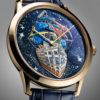A simple Polka step…
It’s called Polka and it’s not a dance, but a watch. Hermès named it after its gold bracelet featuring rhythmical patterns. When I first discovered it during the Watches & Wonders show in Geneva last April, my imagination began to run wild. I dreamed that a secret code was embedded in its links and I wrote this story. Isabelle Cerboneschi. Photos & style: Buonomo & Cometti.
I walk up the street towards the railway station in the small town where I grew up. Its name matters little, since every small town has a station road. How long has it been since I’ve been back here? Ten years? Maybe more. The reasons that made me leave have very little to do with those that have made me return.
I turn left and walk down the street that runs past the casino. I sometimes dream that a watchmaker will invent a watch to go back in time – if only for a few hours.
If it were possible, I would turn the clock back to that summer as a 15 year-old. To relive that golden age again in this little lakeshore town, where the living was easy… and far too slow for a young man like me. To relive that summer. That sweetness. That love. Her name was L.
She radiated a beauty that transcended beauty. All the boys were in love with her and she chose me, the shy one a little too tall for his age who read her The Songs of Maldoror and poems by Lamartine when we were alone and she let me kiss her.
We had invented a code, a language of our own inspired by Morse code. In high school, during French classes, we would tap our foot against the chair: one short, three long and four short sounds meant: “I love you”. Our alphabet was confined to these essential words: one dot, three dashes and four more dots, which we wrote on little pieces of paper that we sent flying from one row to the next. Some of the boys in the class occasionally intercepted them, but since they never understood what it meant, they let it go.
I walk past the casino whose immaculate, baroque design makes it look like like a Pavlova but without the strawberries. I want to see the interior again. It will be useful to me, as I need some material for my new novel and maybe I will meet an unlikely individual, far more surreal than my inventions.
The bar on the left, with its dark woodwork and deep red velvet-upholstered armchairs, looks as if it’s been there forever. It has indeed always been there, I think to myself. I sit down and order a whiskey sour; the bartender slides it over the bar, without a word, as spotlights illuminate the stage. An auburn-haired woman emerges, her curvaceous body highlighted by a golden leotard set with white sequins sparkling like diamonds. She pronounces no greeting, says nothing and looks at no-one, her gaze instead escaping well behind the meagre audience sitting in the bar. She simply waits for the music to start, a tune from the 1950s, like in Fred Astaire musicals. She starts to tap dance – rather well in fact. She glides, twirls, flies and spins across the wooden floor.
Her gaze meets mine and her eyes are flecked with gold. I’m not sure if it’s an effect created by the spotlights or if it’s true, but whereas she seemed to have seen no-one, her eyes linger on me. I am slightly disturbed by this. Suddenly, without waiting for the music to change, she begins to perform a polka piquée dance. She’s lost the tempo. It’s embarrassing. I drink up, pay and leave. The dancer has not finished her number, but I have seen enough. A good part, probably the best part, of this woman’s life is behind her. Maybe I should have stayed, gone to her dressing room, talked to her, listened to her mothering one of my fictional characters.
I leave the casino and head towards the apartment I’ve rented for a few days – a former dance school transformed into a loft with a pool upstairs. It’s both strange and beautiful. It’s far too big for me, but I chose it deliberately: the old ballet school was ours, the one where L and I used to come for classes when we were teenagers. She convinced me to go with her. I sucked at soccer and all team sports. I was loose-limbed and naturally supple, so why not try ballet? Together we learned the pas de deux from Swan Lake while being regularly whacked in the knees by our former ballet teacher, a Russian emigrant who had never read Françoise Dolto. I was Siegfried, L. was Odette, and I could embrace her in full view of everyone without anyone finding fault. It was both disturbing and sweet.
I think of L. while gazing at the sky through the immense glass roof. The stars form figures against the dark velvet canopy of the night. A single star appears next to some clouds, forming oblique lines, followed by four more stars. I don’t know why, but thoughts of the tap dancer from earlier this evening come to mind. And suddenly I have a vague memory, something about time running backwards. As if it were possible. I remember her last steps, her backwards taps that made these movements: one step, three brushes and two ball changes; one short beat, three long beats, four short beats; one dot, three dashes, four dots. But of course, those golden eyes… How did I not recognise her? It is L.
I grab my keys, my jacket and storm out of the apartment, rushing towards the casino located two blocks away. The stage is empty. I turn to the bartender and ask him if he knows the girl who danced earlier. He doesn’t know her name: she sometimes comes to perform free of charge and never asks for anything, just a little light and music. Then she disappears for a week, a month, but she always comes back.
He then takes out a gold watch from his till. He places it in front of me and says: “She asked me to give you this: she was sure you would come back tonight.” I take this delicate object in my hands: its dial bears the Hermès signature. I gaze at its bracelet which resembles a gold sculpture and suddenly I understand: one diamond, two gold lines, four diamonds. She was telling me “I love you” beyond the bounds of time…
















